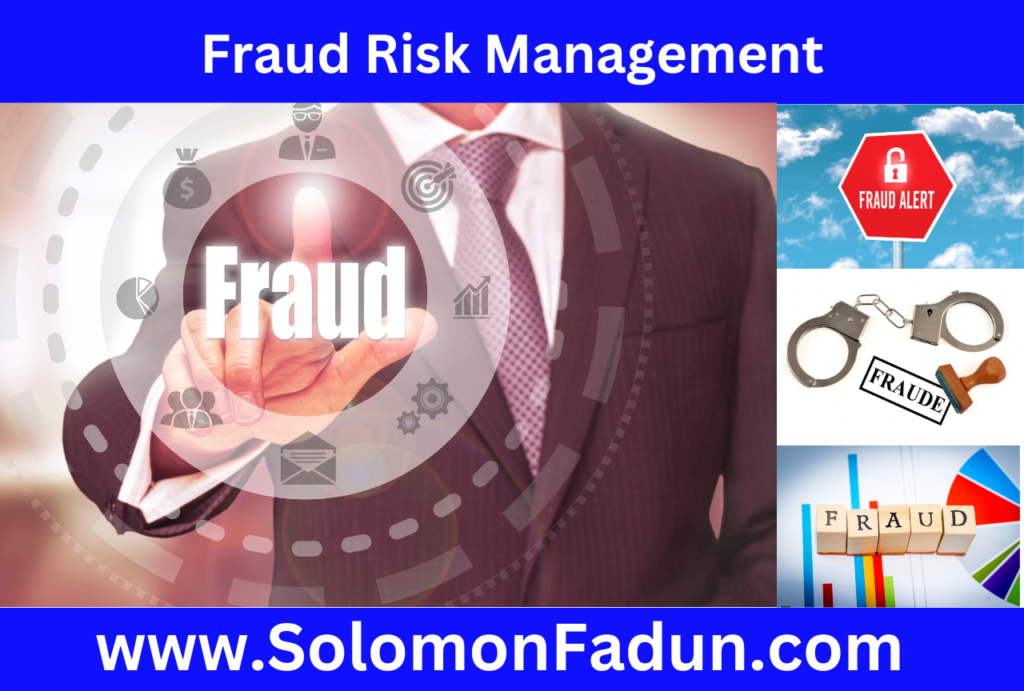Fraud Risk &
Fraud Risk Management

This post discusses fraud risk and fraud risk management. In this post, you will understand the meaning of fraud risk and the management of fraud risks.
All organisations are susceptible to fraud risks. Fraud and fraud risks have increased in recent years. It happens when you least expect it. Fraud affects every aspect of our lives, including buying and selling products or assets, voting in an election, or receiving a bank loan. Fraudsters are using new technology to attempt to scam new victims out of large amounts of money. Regardless of the way it is perpetrated, fraud impacts businesses negatively.
WHAT IS A FRAUD?
Fraud is any intentional act or omission designed to deceive others, resulting in the victim suffering a loss and the perpetrator achieving personal gain. Fraud is any attempt by an agent, officer, employee, or representative of a business or other entity to induce another person or entity to give specific information about the goods or services offered or the interest rates or fees that may be paid. Fraud is an attempt by a person to obtain access to something or profit by misleading others.
Fraud commonly includes theft, corruption, conspiracy, embezzlement, money laundering, bribery, and extortion. The legal definition varies from country to country, but fraud generally involves using deception to dishonestly make a personal gain for oneself or create a loss for another. All organisations are exposed to fraud risks regardless of size, industry, and country of operations. Effective handling of fraud cases within an organisation would send clear signals to the public, stakeholders, and regulators about the board and management’s attitude toward fraud risks and the organisation’s fraud risk tolerance.
TYPES OF FRAUD
Fraud could mean several things, which may arise from diverse relationships between offenders and victims. Most types of fraud can be classified into six categories:
1. Asset misappropriation,
2. Vendor fraud,
3. Accounting fraud,
4. Bribery and corruption,
5. Payroll fraud, and
6. Data theft.
WHAT IS CORRUPTION?
Corruption is the misuse of power or authority for selfish purposes. The term comes from the ancient Greek word “kritos” which means correct, proper or just. Corruption affects an institution’s integrity and harms society’s reputation when discovered. Corruption is unethical behaviour aimed at gaining an advantage through unlawful means. It occurs when someone in a position of trust or authority permits personal gain at the expense of the public good. There are several forms of corruption, including bribery, extortion, embezzlement, abuse of power, and money laundering.
REASONS PEOPLE COMMIT FRAUD
There are many things that people think when they commit fraud. They may not think about it for long before they perpetrate the act. There are several reasons why people commit fraud. Here are three significant reasons why people commit fraud:
1. Pressure,
2. Opportunity, and
3. Rationalisation.
These three reasons people commit fraud are known as the ‘Fraud Triangle’. These three reasons why people commit fraud (pressure, opportunity, and rationalisation) are the components of the fraud triangle. The fraud triangle presumed that fraud would likely result from these three factors: pressure or motivation, opportunity, and rationalisation. Now, let us discuss the three components of the fraud triangle.
WHO COMMITS FRAUD?
In today’s global marketplace, fraud has become a significant challenge. Businesses of all sizes and industries often face the challenge of managing fraud. Fraudsters will find ways to exploit weaknesses in business organisations. Fraud constitutes both internal and external threats to business organisations. Hence, fraud can be perpetrated by both external and internal fraudsters.
TYPES OF FRAUDSTERS
The term “fraudster” comes from a Latin word that means deceptive, invented, or invented. To commit fraud is to use misleading or fabricated information to accomplish an illegitimate intention and unlawful acts. There are several types of fraudsters. Fraudsters can be classified into three categories:
1. Pre-planned,
2. Intermediate, and
3. Slippery slope.
PROFILES OF FRAUDSTERS
There are two broad profiles of fraudsters:
1. Opportunity fraudsters, and
2. Professional fraudsters.
FRAUD RISK MANAGEMENT
Fraud risk management entails companies’ processes and approaches to protecting themselves from being defrauded by their customers or investors. Fraud risk management involves identifying, assessing, and managing fraud and related risks. Fraud management aims to prevent the loss of funds by detecting and preventing fraud against an organisation. Business organisations should have efficient policies and procedures to identify, monitor, and mitigate potential fraud risks to ensure sound fraud risk management. For example, financial institutions should engage suitable tools and techniques to track and manage customer data, including financial and payment record information.
FRAUD RISK MANAGEMENT PROCESS
Fraud risk management is the process of managing fraud risks by organisations. The fraud risk management process involves identifying, evaluating, and preventing fraudsters (internal and external) from defrauding the company. This process helps to ensure that the company engage in anti-fraud measures by collecting, managing, and disseminating information on fraud across the organisation.
Here are the eight steps of a fraud risk management process:
1. Fraud management planning,
2. Identification of potential fraud risks,
3. Fraud risk assessment,
4. Fraud risk prioritisation,
5. Development of fraud risk management policy,
6. Communication fraud management policy,
7. Implementation of fraud management policy, and
8. Review and monitoring of fraud management policy.
PRINCIPLES OF A SOUND FRAUD RISK MANAGEMENT
Fraud risk management is an ongoing process that helps protect customers and employees against fraud. It involves a range of measures, including the design and implementation of risk analysis tools, education to encourage good behaviour and adoption of good fraud risk management practices. An effective fraud management system provides structures and protocols to prevent fraud and assist businesses in communicating the necessary actions and consequences of fraud to all stakeholders.
Here are the five principles of an effective fraud risk management strategy:
1. Fraud risk governance,
2. Fraud risk assessment,
3. Fraud risk prevention,
4. Fraud risk detection, and
5. Fraud risk monitoring and reporting.
These principles of an effective fraud risk management strategy provide a framework for organisations to assess risk and implement a detailed programme for preventing possible fraud.
See my video on Fraud Risk and Fraud Risk Management: https://youtu.be/sn1Zj6-7tNs

VIDEO TIMESTAMPS
00:00 – Introduction
00:51 – The meaning of fraud
03:00 – Types of fraud
03:25 – Asset misappropriation
04:15 – Vendor fraud
05:14 – Accounting fraud
06:35 – Bribery and corruption
08:19 – Payroll fraud
09:49 – Data theft
11:26 – Reasons why people commit fraud
15:24 – Who commits fraud?
16:36 – Types of fraudsters
19:23 – Profiles of fraudsters
20:59 – Fraud risk management
21:45 – Fraud risk management process
31:02 – Principles of a sound fraud risk management
39:14 – Conclusion
